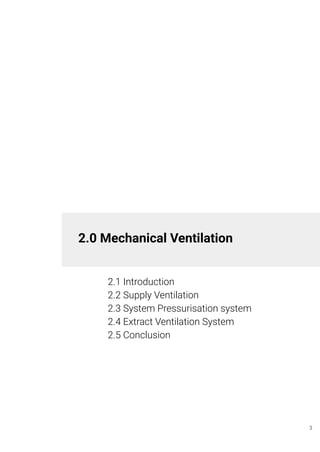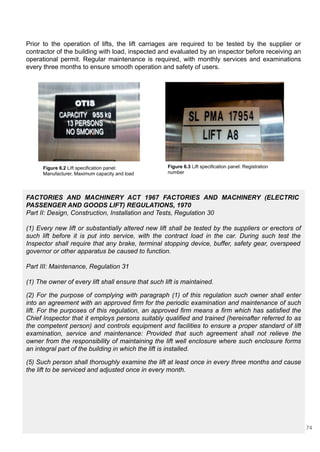This document provides a case study of the building services systems in Menara Mustapha Kamal, Block A of PJ Trade Centre, a 22-storey commercial building. It examines the mechanical ventilation, air conditioning, passive fire safety, active fire protection, and mechanical transportation systems. For mechanical ventilation, it describes the supply ventilation, pressurization, and extract ventilation systems. The air conditioning system uses a chilled water central system with air handling units, chillers, cooling towers, and a pipe system. It also analyzes the passive fire safety features like compartmentalization and the active fire alarm and sprinkler systems. Finally, it examines the gearless traction lift systems and fire lifts that provide transportation. In conclusion,











































![Purpose
group
(1)
Maximum dimension Minimum period of fire resistance (in
hours)
Height
(in m)
(2)
Floor area
(in m²)
(3)
Cubic
capacity
(in m ²)
(4)
Ground storey or
upper storey
(5)
Basement
store
(6)
IV (Office) ... No limit No limit No limit 1½ 2
Uniform Building By-Laws 1984
Ninth Schedule
Limits of Compartments and Minimum Periods of Fire Resistance for Elements of Structure
[By-law 142 (3), 147, 158 (1), 162, 213, 216 (2)]
(Minimum periods of fire resistance)
In this Table- “cubic capacity” means the cubic capacity of the building or if the building is
divided into compartments, the compartment of which the element of structure forms part;
“floor area” means the floor area of each of each storey in the building or, if the building is
divided into compartments, of each storey in the compartment of which the element of structure
forms part;
‘height” has the meaning assigned to the expression by paragraph (2) of by-law 215
PART I-BUILDINGS OTHER THAN SINGLE STOREY BUILDINGS
for elements of structure (*) forming part of -
39](https://image.slidesharecdn.com/bservice-190725030935/85/Bservice-44-320.jpg)

























































![Image References
Introduction
Krishnan, G. (2016). Power Cut at PJ Trade Centre Due to Fire. Retrieved from
https://www.lipstiq.com/2016/114811/tnb-cable-catches-fire-causing-disruption-around-pj-trade-centre/
Havel, G. (2011). Elevators: Power Shunt Trip. Retrieved from
https://www.fireengineering.com/articles/2011/02/elevators-power-shunt-trip.html
Mechanical Ventilation
Stairwell pressurisation system, retrieved from: https://stlfamilylife.com/photo/stairwell-pressurization-fans.html
Types of Ventilation Systems. (n.d.). Retrieved from
https://www.hometips.com/how-it-works/ventilation-systems-exhaust.html
Air Conditioning System
Evans, P. (2015). [The refrigerant cycle in chiller]. Retrieved from
https://theengineeringmindset.com/chiller-cooling-tower-air-handling-unit-work-together/
Evans, P. (2019). [Water cooled chiller with components labelled]. Retrieved from
https://theengineeringmindset.com/building-services-engineering-intro/
Jin-Hui Plastics Industrial Co., Ltd. (n.d.). [Cross flow cooling tower]. Retrieved from
https://cooling-towers.com.tw/solution/cooling-tower-knowledge/closed-circuit-cooling-tower-technology/cross-flow-
vs-counter-flow-how-about-mix-flow
Jin-Hui Plastics Industrial Co., Ltd. (n.d.). [Counter flow cooling tower]. Retrieved from
https://cooling-towers.com.tw/solution/cooling-tower-knowledge/closed-circuit-cooling-tower-technology/cross-flow-
vs-counter-flow-how-about-mix-flow
Lytte. (n.d.). [Vertical Air Handling Unit]. Retrieved from
https://www.alibaba.com/product-detail/HVAC-Systems-and-Parts-Vertical-Cabinet_60063024236.html
Saleh, J. J. (2015). Types of ac units-hvac-apex[PDF]. Apex.
Wiring Diagram. (n.d.). [How split unit work]. Retrieved from
https://www.google.com.my/url?sa=i&source=images&cd=&cad=rja&uact=8&ved=2ahUKEwjXspjO1KTiAhXELY8K
HYGCCe4Qjhx6BAgBEAM&url=https://r37.autohaus-walch.de/mini-split-how-works-diagram.html&psig=AOvVaw2
EQHYhCHTh5eOXmC6NFpdN&ust=1558254526108593
Warmair. (n.d.). Refrigeration cycle [Refrigeration cycle]. Retrieved from
http://www.warmair.com/html/refrigeration_cycle.htm
Active Fire Protection System
Fire Extinguishers « AGA Malaysia Sdn. Bhd. (2019). Retrieved from
http://agamalaysia.com.my/products/fire-extinguishers/
Hamzah Abu Bakar. (2006). Guide to fire protection in Malaysia. Kuala Lumpur: The Institute of Fire Engineers (UK)
Malaysia Branch.
97](https://image.slidesharecdn.com/bservice-190725030935/85/Bservice-102-320.jpg)


![References
Mechanical Ventilation
Greeno, R. (2015). Building services, technology and design. London: Routledge.
Hall, F., & Greeno, R. (2015). Building services handbook. Abingdon: Routledge.
Air Conditioning System
Ananthanarayanan, P. N. (2013). Basic refrigeration and air conditioning. Tata McGraw-Hill Education.
Evans, P. (2019, May 18). How a Chiller, Cooling Tower and Air Handling Unit work together. Retrieved from
https://theengineeringmindset.com/chiller-cooling-tower-air-handling-unit-work-together/
Greeno, R. (2015). Building services, technology and design. London: Routledge.
Ho, G. W., Kitching, R., Siu, A., & Yang, C. (2018). Arups tall buildings in Asia stories behind the storeys. London:
Routledge/Taylor & Francis Group.
Hoffman, P. (n.d.). Ag Power Web Enhanced Course Materials. Retrieved from
https://www.swtc.edu/Ag_Power/air_conditioning/lecture/basic_cycle.htm
Khemani, H. (2018, November 12). Installation of the Split Air Conditioners: Deciding the Location of Indoor and
Outdoor Units. Retrieved from
https://www.brighthubengineering.com/hvac/45249-indoor-and-outdoor-installation-of-split-air-conditioners-deciding
-the-location/
McDowall, R. (2007). Fundamentals of HVAC systems: SI edition. Amsterdam: American Society of Heating,
Refrigerating and Air-Conditioning Engineers eLearning.
Penerbitan Akta (M). (2010). Uniform Building By-laws 1984 (G.N. 5178/1984). Selangor Darul Ehsan.
Prasad, M. (2006). Refrigeration and air conditioning. New Delhi: New Age International Pub.
RABIAH, T. (2007, August 01). HVAC and Fire Safety for Elevator Systems. Retrieved from
https://www.csemag.com/articles/hvac-and-fire-safety-for-elevator-systems/
Stanford III, H. W. (2016). HVAC water chillers and cooling towers: fundamentals, application, and operation. CRC
Press..
Truwater Cooling Towers Sdn. Bhd. (2016). EXS 2016 Catalogue[PDF]. Petaling Jaya: Truwater Cooling Towers
Sdn. Bhd.
Yao, W. (2016, October 28). A Combined Water Tank for Underground Metro Stations. Retrieved from
https://www.wsp.com/en-GB/insights/an-innovative-idea-a-combined-water-tank-for-underground-metro-stations
100](https://image.slidesharecdn.com/bservice-190725030935/85/Bservice-105-320.jpg)
